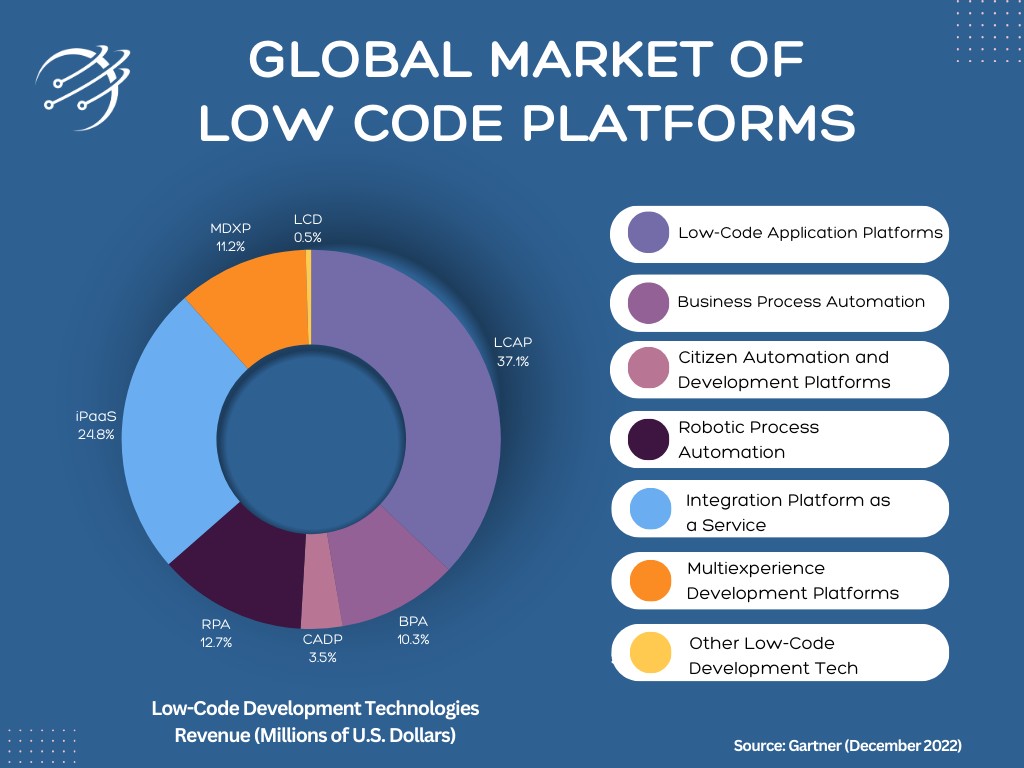The emergence of low code platforms, which started more than a decade ago, took the software development industry by storm.
Businesses across industries were looking for fast resolutions to develop and deploy software applications to stay afloat in the competitive market, especially during the COVID-19 pandemic. These organizations then turned to low code to automate workflows and accelerate development. The platform’s ability to combine the flexibility of no code and high code solutions revolutionized application development.
Cut to 2023. It has been almost 12-13 years since, and the low code boom has shown no sign of slowing down. In fact, in two decades of my experience, I have seen the trend evolve and expand at a faster pace in the last three years.
When Gartner released its forecast for the year, the report stated that the low code development technologies will contribute to a whopping $26.9 billion globally in 2023. This meant a growth of 19.6% from 2022, which was a little under $22.5 billion.

A Glimpse Into 2023
The low code market has shown promise in 2023 and I bear witness to that.
The pandemic had been a blessing in disguise for low code as several organizations looking to get efficient and agile relied on these platforms to accelerate their digital journeys. Post-pandemic, these success stories speak about the magnitude of business evolution that happened in the last year.
Innovation has been the hallmark of the year, and low-code platforms have emerged as the undisputed champions for enterprises. However, certain trends drove interest and investments in low code platforms this year.
Comprehensive Application Development Toolkit
With diverse customer needs, enterprises wanted to expedite the creation of applications in the ever-shifting market dynamics. Digital platforms with low code capabilities were at the core of this transformative endeavor, upholding the crucial tenets of security and compliance. These platforms included an innovative ecosystem with the ability to craft intricate business applications, end-user portals, multifaceted business processes, and seamless integrations with third-party systems.
Improvement Through Intelligence
Every enterprise aims for continuous improvement and innovation as they strive to become faster and more efficient. These goals can be only achieved with a thorough assessment of tasks, analysis, and identification of operational bottlenecks. With the key features of low code platforms, organizations have managed to incorporate analytics-based process discovery, connected application development, and one-click deployment in their business operations. Investing in a low code platform that is adept with AI capabilities has helped enterprises optimize day-to-day operations and ensure intelligent decision-making in their core processes and customer journeys.
Intuitive User Interface (UI)
A refined user interface can ensure an exceptional end-user experience. However, the pursuit of creating a flawless UI is riddled with significant challenges, especially when operational processes are intertwined with legacy systems. The adoption of a low-code platform with a headless approach, where the front- and back-end processes are decoupled from the UI. This approach empowered enterprises to construct seamless and tailored UI experiences with help from diverse technologies.
The Great Resignation Wave
Global organizations, especially the IT sector, witnessed a wave of resignations this year, leading to sluggish project deliveries and interrupted business functions. TeamLease’s 2022 Talent Exodus report claimed that over 2 million IT employees in India were expected to leave their jobs by 2025. Forward-thinking enterprises decided to navigate the choppy waters of the Great Resignation and empowered IT teams to execute a myriad of tasks swiftly and efficiently, at scale, with low-code platforms.
What’s Next?
Low code is here to stay! The data is all in favor of low code technologies with a strategic approach. The year-on-year growth in low code platform adoption, surpassing 20%, is a testament to its effectiveness. This robust growth reflects the confidence businesses have in these platforms.
Around 70% of new applications developed by enterprises will use low code or no-code technologies by 2025, as per the Gartner 2021 research forecast analysis.
In years to come, enterprises will continue to require an all-encompassing, seamlessly modular, and fully integrated low-code platform, boasting these very capabilities. The increasing adoption signifies the recognition of low code platforms as essential tools for modern businesses, underlining their significance in the technological landscape.
Technological advancements like artificial intelligence (AI), Generative AI (GenAI), and machine learning, among others, will keep innovating low code platforms to foster a user-centric digital environment.
Here’s how 2024 looks for low code platforms:
Hyper Acceleration with GenAI
The year 2024 promises to boost low code platforms with the capabilities of GenAI. This groundbreaking technology will revolutionize application development by providing hyper acceleration. It will empower developers to create intelligent, adaptive, and highly efficient applications, further enhancing the capabilities of low code platforms and expanding their adoption across various industries.
GenAI will play a pivotal role in making low code platforms more business friendly. By automating complex tasks and assisting developers in creating advanced applications, GenAI will enhance the user experience, making the platforms more accessible to businesses with varying technical expertise. This increased accessibility will drive wider adoption, leading to a more extensive and diverse user base.
University Certification Programs
The introduction of university certification programs focusing on low code platforms will revolutionize the way developers are trained. These programs will equip students with the skills and knowledge necessary to leverage low code platforms effectively. Consequently, enterprises will benefit from a pool of certified professionals, streamlining the hiring process and ensuring a skilled workforce proficient in low code application development.
Final Word
As we step into 2024, low code platforms are poised to continue their transformative journey, powered by innovations like Generative AI and comprehensive education initiatives. The amalgamation of flexibility, speed, adaptability, and accessibility will solidify the position of low code platforms as indispensable tools in the realm of application development, shaping the future of businesses worldwide.
Moreover, innovation with the right execution is another area to look at. Finding the right partner that uses innovative processes and understands your business needs is also vital.
You might be interested in



25 Sep, 2025
Transforming Enterprises with Newgen’s Business Process Management Software

